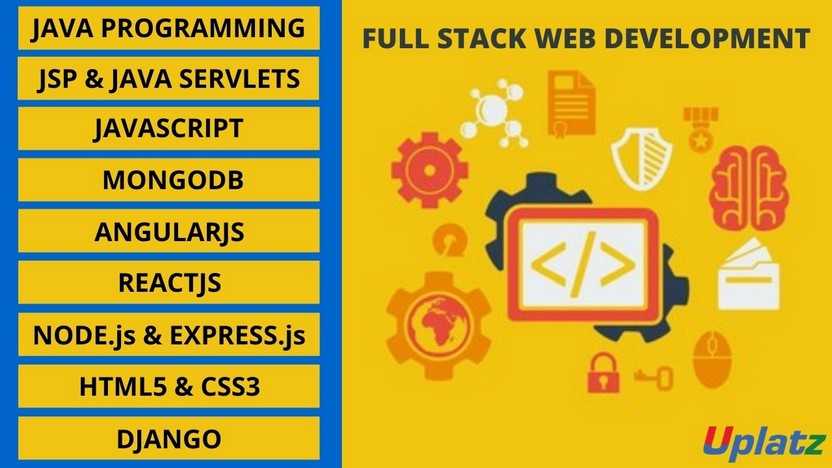Interview Questions - ReactJS
You become familiar with the process and gain the skills you'll need to become a professional React developer. Price Match Guarantee
Full Lifetime Access
Access on any Device
Technical Support
Secure Checkout
Course Completion Certificate
Price Match Guarantee
Full Lifetime Access
Access on any Device
Technical Support
Secure Checkout
Course Completion Certificate
 87% Started a new career
BUY THIS COURSE (
87% Started a new career
BUY THIS COURSE (GBP 12 GBP 29 )-
 97% Got a pay increase and promotion
97% Got a pay increase and promotion
Students also bought -
-

- Career Path - Cybersecurity Engineer
- 100 Hours
- GBP 32
- 1240 Learners
-

- Bundle Course - Full Stack Web Development
- 200 Hours
- GBP 22
- 3788 Learners
-

- Salesforce Administrator
- 5 Hours
- GBP 12
- 230 Learners

This course by Uplatz focuses on commonly asked interview questions on ReactJS.
These ReactJS Interview Questions have been designed specially to get you acquainted with the nature of questions you may encounter during your interview for the subject of ReactJS. Normally questions start with some basic concept of the subject and later they continue based on further discussion and what you answer.
React JS is a JavaScript library, commonly used to develop software that is constantly refreshing data on its UI. This technology eliminates the need of reloading the whole screen and also avoids processing every single line of code. React JS allows you to create components actually made with JavaScript; the famous scripting language used to create interactive applications and interfaces. If you’re using an app that is constantly updating its data, then it was probably developed with JavaScript. React has been designed from the start for gradual adoption, and you can use as little or as much React as you need. Whether you want to get a taste of React, add some interactivity to a simple HTML page, or start a complex React-powered app, the links in this section will help you get started.
React JS is called a JavaScript Library since it can be used mostly to create, store and use JavaScript applications, allowing you to discard the burden of writing the same script by hand over and over again by picking what you need and adding it directly to your code. It can metaphorically be seen and interpreted as a library for storing scripts. This is paradise if your objective is the fast development of very interactive apps and websites.
ReactJS presents graceful solutions to some of front-end programming’s most persistent issues. It’s fast, scalable, flexible, powerful, and has a robust developer community that’s rapidly growing. There’s never been a better time to learn React. The main objective of this React Certification course is to help you become familiar with the process and gain the skills you'll need to become a professional React developer.
Course/Topic - Interview Questions - ReactJS - all lectures
-
In this tutorial, you will learn about the different questions frequently being asked by any interviewer to the candidates about ReactJS like the difference between Real DOM and Virtual DOM, What is React, what are the limitations of React among many others. With the help of this tutorial, you will be able to clear any interview on ReactJS, giving the most appropriate answers to the questions being asked and will succeed in getting a high paid job in an organization.
• Learn about interview questions that will help you prepare for your Reactjs interview.
• For less-experienced developers (or those who’ve been out of the job market for a while), demonstrating your knowledge at the interview stage can be daunting.
• Learn about the most basic React js interview questions as well as some intermediate and advanced ReactJS interview questions and answers for experienced.
• If you have already decided to give it a try and join the industry, we have React interview questions that you should prepare for.
The ReactJS Certification ensures you know planning, production and measurement techniques needed to stand out from the competition.
React. js is an open-source JavaScript library that is used for building user interfaces specifically for single-page applications. It's used for handling the view layer for web and mobile apps. React also allows us to create reusable UI components.
React is a JavaScript library (not a framework) that creates user interfaces (UIs) in a predictable and efficient way using declarative code. You can use it to help build single page applications and mobile apps, or to build complex apps if you use it with other libraries.
The React Nanodegree certification program will teach you what goes into building a successful ReactJS application. From understanding React's architecture and key concepts to learning how to build your own app from scratch, this nanodegree covers everything you need to know to understand and design with React
React has a good learning curve in comparison to other web development frameworks, and so you should have no trouble learning the basics in a few days or weeks, and mastering the language in a few months.
Uplatz online training guarantees the participants to successfully go through the ReactJS Certification provided by Uplatz. Uplatz provides appropriate teaching and expertise training to equip the participants for implementing the learnt concepts in an organization.
Course Completion Certificate will be awarded by Uplatz upon successful completion of the ReactJS online course.
The ReactJS draws an average salary of $120,000 per year depending on their knowledge and hands-on experience.
JS developers can earn around INR 400,000 per annum with less than one year of experience. Early level React. JS developers with 1 to 4 years experience get around INR 540,000 per annum. A mid-level web developer with 5 to 6 years experience earns INR 1,300,000 per annum in India.
But especially for smaller scale and simpler applications, React Native can be a great choice. React Native is not just a powerful framework that you can learn, it's also a great career choice with many high-paying jobs available.
Note that salaries are generally higher at large companies rather than small ones. Your salary will also differ based on the market you work in.
ReactJS Developer.
Software Developer.
ReactJS Lead.
Sr. ReactJS Developer.
1. Differentiate between Real DOM and Virtual DOM.
|
Real DOM vs Virtual DOM |
|
|
Real DOM |
Virtual DOM |
|
1. It updates slow. |
1. It updates faster. |
|
2. Can directly update HTML. |
2. Can’t directly update HTML. |
|
3. Creates a new DOM if element updates. |
3. Updates the JSX if element updates. |
|
4. DOM manipulation is very expensive. |
4. DOM manipulation is very easy. |
|
5. Too much of memory wastage. |
5. No memory wastage. |
· React is a front-end JavaScript library developed by Facebook in 2011.
· It follows the component based approach which helps in building reusable UI components.
· It is used for developing complex and interactive web and mobile UI.
· Even though it was open-sourced only in 2015, it has one of the largest communities supporting it.
3. What are the features of React?
Major features of React are listed below:
i. It uses the virtual DOM instead of the real DOM.
ii. It uses server-side rendering.
iii. It follows uni-directional data flow or data binding.
4. List some of the major advantages of React.
Some of the major advantages of React are:
i. It increases the application’s performance
ii. It can be conveniently used on the client as well as server side
iii. Because of JSX, code’s readability increases
iv. React is easy to integrate with other frameworks like Meteor, Angular, etc
v. Using React, writing UI test cases become extremely easy
5. What are the limitations of React?
Limitations of React are listed below:
i. React is just a library, not a full-blown framework
ii. Its library is very large and takes time to understand
iii. It can be little difficult for the novice programmers to understand
iv. Coding gets complex as it uses inline templating and JSX
JSX is a shorthand for JavaScript XML. This is a type of file used by React which utilizes the expressiveness of JavaScript along with HTML like template syntax. This makes the HTML file really easy to understand. This file makes applications robust and boosts its performance. Below is an example of JSX:
|
1 2 3 4 5 6 7 8 9 10 11 |
render(){ return(
Hello World from Edureka!!
); } |
7. What do you understand by Virtual DOM? Explain its works.
A virtual DOM is a lightweight JavaScript object which originally is just a copy of the real DOM. It is a node tree that lists the elements, their attributes and content as Objects and their properties. React’s render function creates a node tree out of the React components. It then updates this tree in response to the mutations in the data model which is caused by various actions done by the user or by the system.
This Virtual DOM works in three simple steps.
1. Whenever any underlying data changes, the entire UI is re-rendered in Virtual DOM representation.
2. Then the difference between the previous DOM representation and the new one is calculated.
3. Once the calculations are done, the real DOM will be updated with only the things that have actually changed.
8. Why can’t browsers read JSX?
Browsers can only read JavaScript objects but JSX in not a regular JavaScript object. Thus to enable a browser to read JSX, first, we need to transform JSX file into a JavaScript object using JSX transformers like Babel and then pass it to the browser.
9. How different is React’s ES6 syntax when compared to ES5?
Syntax has changed from ES5 to ES6 in the following aspects:
i. require vs import
|
1 2 3 4 5 |
// ES5 var React = require('react');
// ES6 import React from 'react'; |
ii. export vs exports
|
1 2 3 4 5 |
// ES5 module.exports = Component;
// ES6 export default Component; |
iii. component and function
|
1 2 3 4 5 6 7 8 9 10 11 12 13 14 15 16 17 18 19 |
// ES5 var MyComponent = React.createClass({ render: function() { return
Hello Edureka!; } });
// ES6 class MyComponent extends React.Component { render() { return
Hello Edureka!; } } |
iv. props
|
1 2 3 4 5 6 7 8 9 10 11 12 13 14 15 16 17 18 19 20 |
// ES5 var App = React.createClass({ propTypes: { name: React.PropTypes.string }, render: function() { return
Hello, {this.props.name}!; } });
// ES6 class App extends React.Component { render() { return
Hello, {this.props.name}!; } } |
v. state
|
1 2 3 4 5 6 7 8 9 10 11 12 13 14 15 16 17 18 19 20 21 22 23 24 25 26 |
// ES5 var App = React.createClass({ getInitialState: function() { return { name: 'world' }; }, render: function() { return
Hello, {this.state.name}!; } });
// ES6 class App extends React.Component { constructor() { super(); this.state = { name: 'world' }; } render() { return
Hello, {this.state.name}!; } } |
10. How is React different from Angular?
|
React vs Angular |
||
|
TOPIC |
REACT |
ANGULAR |
|
1. ARCHITECTURE |
Only the View of MVC |
Complete MVC |
|
2. RENDERING |
Server-side rendering |
Client-side rendering |
|
3. DOM |
Uses virtual DOM |
Uses real DOM |
|
4. DATA BINDING |
One-way data binding |
Two-way data binding |
|
5. DEBUGGING |
Compile time debugging |
Runtime debugging |
|
6. AUTHOR |
|
|
React Components – React Interview Questions
11. “In React, everything is a component.” Explain.
Components are the building blocks of a React application’s UI. These components split up the entire UI into small independent and reusable pieces. Then it renders each of these components independent of each other without affecting the rest of the UI.
12. What is the purpose of render() in React.
Each React component must have a render() mandatorily. It returns a single React element which is the representation of the native DOM component. If more than one HTML element needs to be rendered, then they must be grouped together inside one enclosing tag such as
etc. This function must be kept pure i.e., it must return the same result each time it is invoked.
13. How can you embed two or more components into one?
We can embed components into one in the following way:
|
1 2 3 4 5 6 7 8 9 10 11 12 13 14 15 16 17 18 19 20 21 22 23 24 25 |
class MyComponent extends React.Component{ render(){ return(
Hello
); } } class Header extends React.Component{ render(){ return
Header Component
}; } ReactDOM.render( , document.getElementById('content') ); |
14. What is Props?
Props is the shorthand for Properties in React. They are read-only components which must be kept pure i.e. immutable. They are always passed down from the parent to the child components throughout the application. A child component can never send a prop back to the parent component. This help in maintaining the unidirectional data flow and are generally used to render the dynamically generated data.
15. What is a state in React and how is it used?
States are the heart of React components. States are the source of data and must be kept as simple as possible. Basically, states are the objects which determine components rendering and behavior. They are mutable unlike the props and create dynamic and interactive components. They are accessed via this.state().









